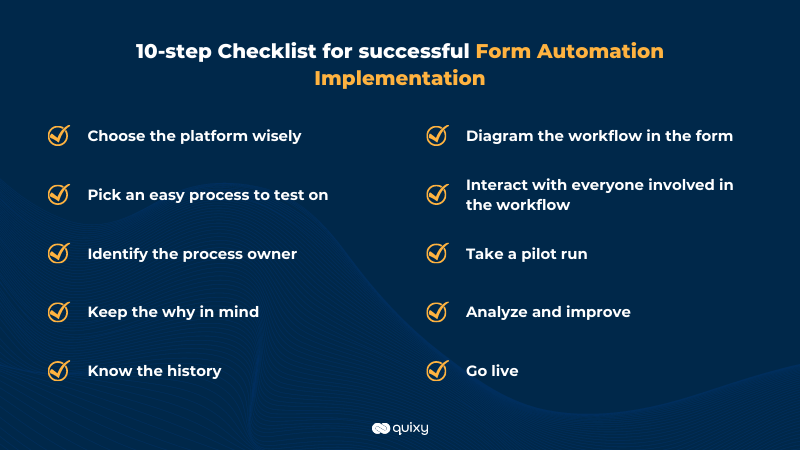
According to a report, the form automation software market is expected to get a stronghold in the global market, with a CAGR of 16.3% between 2022 and 2032.
Do you want to automate your forms and go digital but don’t know where to start? We understand that Form Automation Implementation can initially get extremely overwhelming and confusing, but we also know that the right information can help assuage this hesitancy.
Here’s a 10-step form automation implementation checklist that will help!

1. Choose the platform wisely
It’s essential to pick an excellent form automation platform to create a solid foundation for your workflow. The market is saturated with terrific form automation software tools, but you must choose one with the best features, as this can make or break your processes.
Choosing good software can save you high costs and time in training and maintaining a seamless workflow from customizable options to an easy-to-use interface.
2. Pick an easy process to test on
When starting, you may feel ambitious to choose the most critical or urgent workflow to automate using forms, but it’s a good idea to hold on to your horses and start with something easy to implement.
Starting with unchallenging forms, such as feedback loops, customer details, etc., will give a buffer period to master the form automation software. Once the details are in order and the workflow is flawless, you can move on to heavier and bigger projects that require form automation.
Also Read: A Realistic Look at Automation Struggles in Manufacturing Industry
3. Identify the process owner
Too many cooks spoil the broth; the same applies to workflow. A digital form requires the workflow to travel across various departments, functions, and stakeholders. Identifying a process owner early on is vital to prevent miscommunication within the organization- having a go-to person for taking calls on grey areas that may not fall in any particular department’s jurisdiction helps reduce friction and increase efficiency. The process owner is then accountable for the smooth functioning and organization of the form.
4. Keep the why in mind
Before starting with form automation implementation, one must answer one question: why am I doing this? You may use form automation to save time, cut costs, or even make a strategic business decision like expanding a store to a new geography. The efficiency of the workflow will all come down to the clarity of the goal you intend to achieve.
Chasing multiple goals may be fancy, but productivity peaks when you can narrow your agenda to one objective you wish to fulfill with form automation implementation. Setting reasonable benchmarks in terms of time, human resource costs and outcomes makes a lot of difference for smoother implementation of form automation.
Also Explore: Creating an Efficient Service Checklist Solution for Smooth Operations with No-code
5. Know the history
The main reason for automating forms is to do it better than in the past. But to build the future, it’s essential to learn from the past. The mistakes made, and the history that led up to this decision.
Understanding how the workflow was managed in the past becomes crucial to creating a form that solves the previous problems. From the time taken in the old processes to the number of departments or stakeholders involved in the workflow, knowing the organization’s unautomated history can help significantly reduce trial and error.
Also Read: Top Forms Automation Tools for you
6. Diagram the workflow in the form
While starting with the workflow helps create a visual guide of how you want the form to turn out. Setting up an intuitive record where the fields flow together rather than seem disjointed and unrelated to each other will help reduce bounce rates and increase response rates tremendously.
It may be hard to envision the flow perfectly, but diagramming the workflow will help you insert conditional fields, add attachments, and better design the form for your stakeholders. Keeping it simple is extremely useful when starting, as it prevents unnecessary faff.
7. Interact with everyone involved in the workflow
Once a form is filled and submitted, the data travels through various departments in an organization where multiple stakeholders try to make sense of this data and utilize it to the best of their abilities.
Talking to everyone involved in the workflow early on allows you to anticipate roadblocks, create smoother workflows, and insert relevant fields that help meet organizational goals. Stakeholders can range from the process owner to the end-user who submits the form, and knowing the pain points of every stakeholder will allow you to create a well-structured form.
8. Take a pilot run
A pilot run will help you identify problems that may arise when your form goes live. This can help you figure out the system runtime, the software’s ability to handle a spike in users or even the intuitive flow of the form. A pilot form automation implementation run helps you check if the conditional fields work if the attachment displays correctly, if an email has been sent once the form is filled, and even allows you to experience the time taken during the entire process.
After understanding the various roadblocks, you can go back and make changes or rework fields that may not be good enough.
9. Analyze and improve
Once the pilot has been run, it becomes easy for you to go back and make changes. Analyzing what went wrong is crucial to creating an excellent process from form automation that delivers on business expectations. You can develop insights that benefit the various stakeholders by improving the form’s flow and fields.
Also Read: RIP Paper-Based Forms – It’s time to go Paperless with Forms Automation
10. Go live
Going live once you have a comfortable degree of confidence about your form working is when your implementation checklist is complete. Keeping a close eye on the form’s performance throughout its journey is essential by having routine checks and constant feedback loops.
Takeaway
The best way to power-pack your implementation is to choose the perfect software- what starts well ends well. No-code platforms like Quixy make the implementation of form automation extremely easy to learn and use. Following a minimalistic workflow that simplifies your form for your users and process owners is key to ensuring organizational success. When done right, form automation software becomes easier than making minutes of a meeting!
Frequently Asked Questions(FAQs)
Q. How can you measure form automation success?
Measuring form automation success involves assessing the impact on key performance indicators (KPIs). Track metrics such as reduced processing time, decreased error rates, increased data accuracy, and improved workflow efficiency. Also, analyze cost savings from reduced paper usage and labor. User feedback and satisfaction are crucial indicators, too. Successful form automation should result in streamlined processes, enhanced productivity, and a noticeable positive effect on your business’s bottom line. Evaluating these aspects helps quantify the success and ROI of your form automation implementation.
Q. Overcoming common form automation challenges?
Overcoming common form automation challenges requires proactive steps. Start with thorough planning to identify potential bottlenecks and user resistance. Provide comprehensive training to your team and communicate the benefits of automation. Ensure data security measures are in place, and regularly monitor and adapt your workflows as needed. Seek feedback from users to address any issues promptly.
Q. What steps ensure success form automation implementation?
Successful form automation implementation involves assessing current processes, choosing the right software, planning, data migration, rigorous testing, user training, a controlled pilot phase, gradual scaling, and ongoing monitoring and optimization. This comprehensive approach ensures a smooth transition and maximizes the benefits of automation.
Q. Can form automation integrate with existing software?
Yes, form automation can integrate with existing software and databases. Most modern form automation tools offer compatibility with various software and databases through APIs (Application Programming Interfaces). This allows for seamless data exchange and real-time synchronization, enhancing data accuracy and efficiency in your business processes. The ability to integrate with existing systems is a key feature to consider when choosing a form automation solution.
Q. What types of forms and processes can benefit from automation?
Form automation can benefit a wide range of forms and processes. These include employee onboarding, expense reports, leave requests, customer feedback forms, and purchase orders. Essentially, any paper-based or manual form-based process can be automated to streamline data collection, reduce errors, and improve efficiency, leading to time and cost savings for businesses across various industries.
Login
Please login to comment
0 Comments
Oldest















